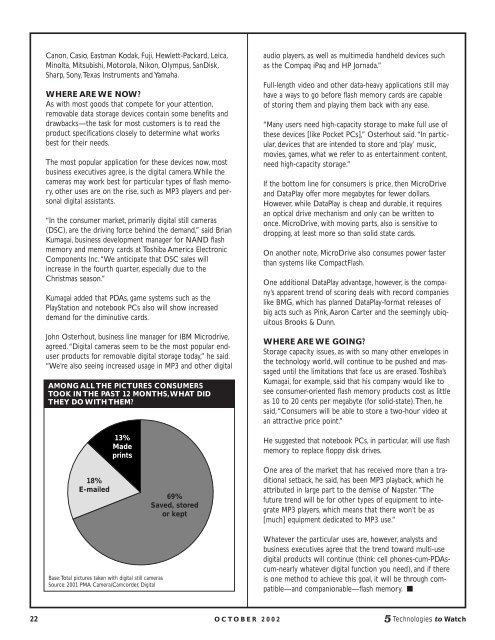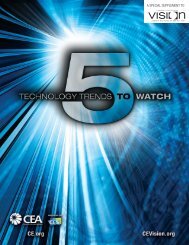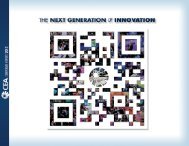Digital Display Technology - Consumer Electronics Association
Digital Display Technology - Consumer Electronics Association
Digital Display Technology - Consumer Electronics Association
- No tags were found...
You also want an ePaper? Increase the reach of your titles
YUMPU automatically turns print PDFs into web optimized ePapers that Google loves.
Canon, Casio, Eastman Kodak, Fuji, Hewlett-Packard, Leica,Minolta, Mitsubishi, Motorola, Nikon, Olympus, SanDisk,Sharp, Sony,Texas Instruments and Yamaha.WHERE ARE WE NOW?As with most goods that compete for your attention,removable data storage devices contain some benefits anddrawbacks—the task for most customers is to read theproduct specifications closely to determine what worksbest for their needs.The most popular application for these devices now, mostbusiness executives agree, is the digital camera.While thecameras may work best for particular types of flash memory,other uses are on the rise, such as MP3 players and personaldigital assistants.“In the consumer market, primarily digital still cameras(DSC), are the driving force behind the demand,” said BrianKumagai, business development manager for NAND flashmemory and memory cards at Toshiba America ElectronicComponents Inc.“We anticipate that DSC sales willincrease in the fourth quarter, especially due to theChristmas season.”Kumagai added that PDAs, game systems such as thePlayStation and notebook PCs also will show increaseddemand for the diminutive cards.John Osterhout, business line manager for IBM Microdrive,agreed.“<strong>Digital</strong> cameras seem to be the most popular enduserproducts for removable digital storage today,” he said.“We’re also seeing increased usage in MP3 and other digitalAMONG ALL THE PICTURES CONSUMERSTOOK IN THE PAST 12 MONTHS,WHAT DIDTHEY DO WITH THEM?13%Madeprintsaudio players, as well as multimedia handheld devices suchas the Compaq iPaq and HP Jornada.”Full-length video and other data-heavy applications still mayhave a ways to go before flash memory cards are capableof storing them and playing them back with any ease.“Many users need high-capacity storage to make full use ofthese devices [like Pocket PCs],” Osterhout said.“In particular,devices that are intended to store and ‘play’ music,movies, games, what we refer to as entertainment content,need high-capacity storage.”If the bottom line for consumers is price, then MicroDriveand DataPlay offer more megabytes for fewer dollars.However, while DataPlay is cheap and durable, it requiresan optical drive mechanism and only can be written toonce. MicroDrive, with moving parts, also is sensitive todropping, at least more so than solid state cards.On another note, MicroDrive also consumes power fasterthan systems like CompactFlash.One additional DataPlay advantage, however, is the company’sapparent trend of scoring deals with record companieslike BMG, which has planned DataPlay-format releases ofbig acts such as Pink,Aaron Carter and the seemingly ubiquitousBrooks & Dunn.WHERE ARE WE GOING?Storage capacity issues, as with so many other envelopes inthe technology world, will continue to be pushed and massageduntil the limitations that face us are erased.Toshiba’sKumagai, for example, said that his company would like tosee consumer-oriented flash memory products cost as littleas 10 to 20 cents per megabyte (for solid-state).Then, hesaid,“<strong>Consumer</strong>s will be able to store a two-hour video atan attractive price point.”He suggested that notebook PCs, in particular, will use flashmemory to replace floppy disk drives.18%E-mailed69%Saved, storedor keptOne area of the market that has received more than a traditionalsetback, he said, has been MP3 playback, which heattributed in large part to the demise of Napster.“Thefuture trend will be for other types of equipment to integrateMP3 players, which means that there won’t be as[much] equipment dedicated to MP3 use.”Base:Total pictures taken with digital still camerasSource: 2001 PMA Camera/Camcorder, <strong>Digital</strong>Whatever the particular uses are, however, analysts andbusiness executives agree that the trend toward multi-usedigital products will continue (think: cell phones-cum-PDAscum-nearlywhatever digital function you need), and if thereis one method to achieve this goal, it will be through compatible—andcompanionable—flash memory. ■22 OCTOBER 2002 5 Technologies to Watch










